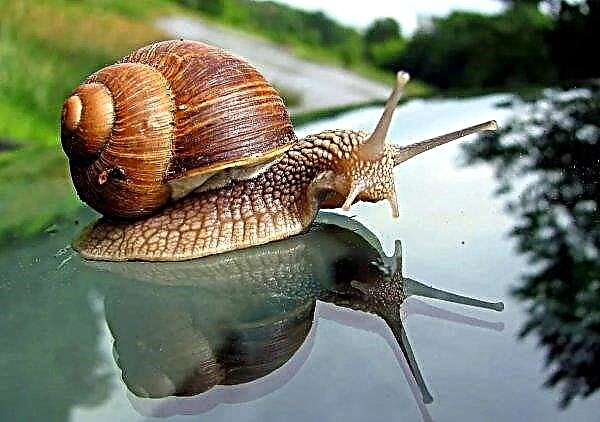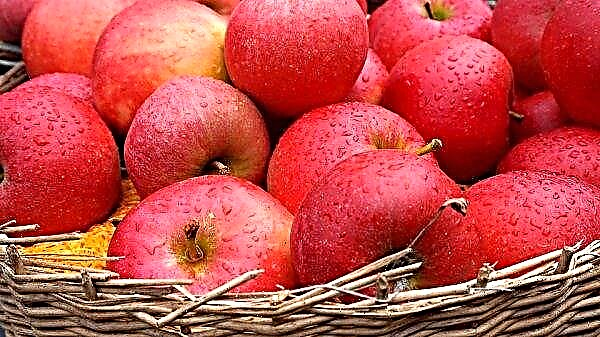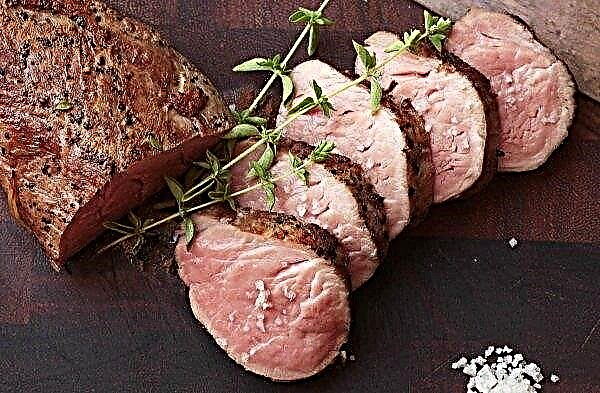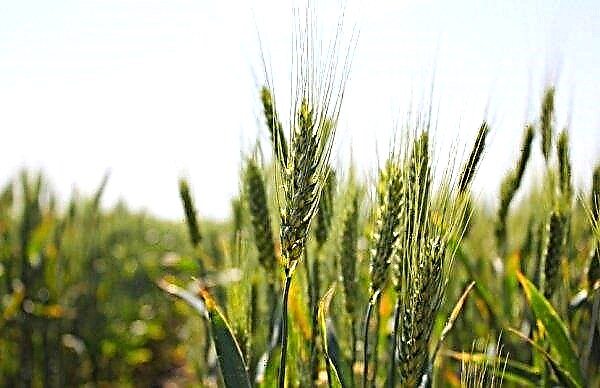Infrared lamps for heating the chicken coop are modern and safe heating devices. There are various types of them with their own design features and rules of use. Let's figure out how to choose an infrared lamp and how to install it correctly.
Chicken house temperature
Comfortable temperature for adult hens ranges from 15–18 ° С. Too high and low rates affect bird productivity. Even taking into account their frost resistance, the minimum allowable temperature is not lower than 8–10 ° С. In winter, when lowering to 5 ° C, egg production decreases. Values below 0 ° C can stop the productivity of chickens.
Features of infrared heaters
Before the onset of cold weather in winter, it is important to think about installing a heating system. The best option for today are considered IR heaters. These devices do not heat the air, but objects in the room. Heating is due to infrared radiation, which is absorbed by solids - for example, walls or interior items.
Did you know? Infrared radiation is, in fact, what is colloquially called "heat." This is how human skin perceives it.
IR heaters are economical in terms of energy consumption, so many farmers with farms of both small and large sizes choose this type of chicken coop heating.
Benefits
- Infrared heaters have many advantages:
- Efficiency up to 97–98%;
- working IR lamps at the same time illuminate the space;
- when using them, the correct microclimate of the room is maintained, humidity does not decrease;
- a device with a power of 250 W heats 9-10 square meters. m .;
- easy to install;
- positively affects the immune system of chickens.
Disadvantages
- Owners of such devices highlight several of their shortcomings:
- too small a distance to the heating object (not higher than 1 m);
- cracks may occur if moisture gets on the lamp;
- Despite being economical, long-term and constant use requires certain financial investments.
Types of infrared lamps
There are several basic types of heating device data. These include stationary, mobile, film and panel.
Did you know? The pioneer of infrared radiation is considered to be an astronomer of English origin, William Herschel, who in 1800 laid the foundation for the study of this phenomenon.
Stationary
Design. Stationary heaters are convenient when installing for a long period of time. Their main feature is fixing at one point of the chicken coop. The design can be different - they include both heating lamps and panels of impressive dimensions. Features This is usually a ceiling heater, which is used for heating large rooms. The advantage for large farms is the availability of temperature controllers, as well as the ability to automate heating, configure several options to choose from in different weather and adjust the power of only one device, while non-stationary panels are more suitable for smaller chicken coops.
Features This is usually a ceiling heater, which is used for heating large rooms. The advantage for large farms is the availability of temperature controllers, as well as the ability to automate heating, configure several options to choose from in different weather and adjust the power of only one device, while non-stationary panels are more suitable for smaller chicken coops.
Mobile
Design. Unlike stationary, mobile lamps are not mounted in one place, but are portable. The design involves easy installation and the ability to rearrange them to another place, so usually mobile heaters consist of a lamp, reflector and cable. Some devices may be equipped with temperature controllers.
Important! Heating from walls works worse than ceiling. However, mobile lamps can also be mounted on the ceiling, which significantly improves the heating of the room.
Features These heating devices are preferred on small and medium sized farms. Such models are less efficient than stationary ones. At the same time, their advantages include the possibility of self-installation and fastening.
Film
Design. The film heater looks like a reflector for batteries. It consists of an outer and inner layer of aluminum coated with a polyester film. Between them is a heating IR element. The film is attached to the desired location in the room and connected to the network. This type of heating can be ceiling, wall and floor depending on the conditions of the chicken coop. Features Unlike lamps, which together with heating provide lighting, the film device is used only for heating. It is preferable to use this type in rooms with low ceilings and a small area. Such heaters are very compact and efficient. The advantage can be called automatic shutdown when a certain temperature is reached - this type is equipped with temperature sensors.
Features Unlike lamps, which together with heating provide lighting, the film device is used only for heating. It is preferable to use this type in rooms with low ceilings and a small area. Such heaters are very compact and efficient. The advantage can be called automatic shutdown when a certain temperature is reached - this type is equipped with temperature sensors.
Panel
Design. Heaters of this type are in the form of panels. They consist of 3 main elements:
- heat reflector (back wall);
- heating device (halogen, carbon or quartz);
- heat conductor (front wall).
 Features Panel heating is relatively mobile, however, for installation, it is necessary to fix special racks in one place. At the same time, the heater can be easily removed and moved. There is also an outdoor option that does not need to be installed. The panels are suitable for small farms and can be used in large chicken coops when installing multiple devices.
Features Panel heating is relatively mobile, however, for installation, it is necessary to fix special racks in one place. At the same time, the heater can be easily removed and moved. There is also an outdoor option that does not need to be installed. The panels are suitable for small farms and can be used in large chicken coops when installing multiple devices.How to choose the right IR lamp
When choosing a heater with infrared radiation, you need to take into account the needs of the chicken coop in heating. When buying a device, pay attention to the following rules:
- The heating level directly depends on the area of the chicken coop. The larger the volume of the room, the more powerful the lamp must be used. So, for large buildings it is better to choose stationary heaters, while small ones can be heated with other types.
- If it is not possible to install a stationary powerful heater, you can heat the room with a few lamps.
- The height of the ceilings is also important. If the walls are higher than 3 meters, it makes sense to install stationary ceiling fixtures with high power. Also suitable is the option of placing panel and film models on the walls.
- To save on the installation of separate lighting, you can use infrared spotlights. It is also recommended to use ultraviolet lamps for additional light.
- Consider the need for thermoregulation. Automatic shutdown when the room is heated to a certain temperature is important in the case when the owner can not constantly control the microclimate on his own.
Video: Types of IR lamps for heating animals
Additional heating methods
In addition to installing heating systems, the chicken coop can be insulated by resorting to other methods. These include various methods of warming the floor, walls, doors and windows.
Deep litter
Deep litter is a type of organic flooring that is laid once for a long time and serves for additional insulation of the floor. Inside such a litter, biochemical processes take place, which allow preserving the temperature of the lower layers of the room to 20–25 ° C in winter even without additional heating. This type of insulation is considered environmentally friendly and contributes to natural disinfection - when interacting with chicken droppings, pathogenic microflora is neutralized.
- moss;
- sawdust;
- peat;
- hay;
- straw;
- shavings.
Insulation of walls, doors and windows
Additional thermal insulation provides insulation of walls, windows and doors, for which different materials are used.
Important! For effective thermal insulation, it is better to insulate the outer surface of the walls.
Wall insulation is carried out using:
- mineral wool;
- polystyrene or expanded polystyrene;
- polyurethane foam.
 The insulation is laid on the outside or inside, the thickness of the material should be at least 5 cm.
The insulation is laid on the outside or inside, the thickness of the material should be at least 5 cm.
The front door is insulated, upholstered with felt or film from the inside. The doorway can also be insulated by filling the slots with mounting foam.
To warm the windows, it is enough to use polyethylene, attaching it to the frame with tape, felt tape or other material. Additionally, the frame is also insulated with sealant.
Infrared lamps allow you to effectively heat the chicken coop and ensure the maintenance of a comfortable microclimate for chickens. Combining infrared heaters and other warming methods, the farmer will successfully prepare the house for the winter season.












